The Tower of Babel
and the Division of the Nations
by Jeffrey J. Harrison
Cities don’t get very positive reviews in the early pages of the Bible. The first city was built by Cain after he was cast out from the presence of the Lord for murdering his brother (Gen. 4:17). The second was Babel with its infamous tower (Gen. 11:9).*
* The cities mentioned in the genealogy of Genesis 10 were probably built later, after the destruction of Babel.
An essential characteristic of an ancient city was its city wall. If there was no wall, it wasn’t considered a city at all, only a town or a village. The first appearance of walled cities marks an important turning point in history.* Historians consider this the beginning of civilization—a word based on the Latin civitas (city
). But city walls and some of the other marks of civilization, like bronze weapons, appeared only for the purpose of defense from the violent attacks of other civilized
societies. Was this really a step forward, as many assume, or was it a giant step backward in man’s moral development?
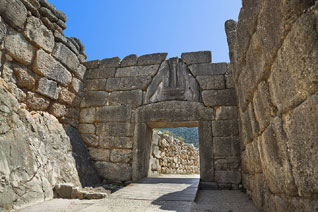
* In what archeologists identify as the Early Bronze Age.
Both the Bible and ancient Mesopotamian documents, as well as modern archeology, identify the time before the advent of civilization as peaceful. This was considered by many a Golden Age, when everyone spoke the same language (Gen. 11:1).* In the Bible, this is the time after the Flood and before the construction of Babel, when many migrated from Ararat (ancient Urartu), where the ark had landed, down to the plain of Shinar (Gen. 11:2).**
* The same memory of a peaceful age with a shared language is preserved in Egypt and in the ancient Hindu (Vedic) literature of India, as well as in Buddhism.
** According to the Hebrew Bible, this migration took about 100 years. According to the Old Greek Bible (the Septuagint) it was about 530 years. This is assuming that Peleg (Division
) was named for the division of the people at Babel (Gen. 10:25, 11:16). Archeologists agree that people moved down from the hilly highlands, though their evolutionary assumptions lead them to assign to this process a much longer period of time.
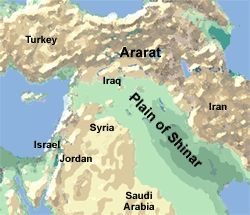
Shinar, which the archeologists call Sumer (the lower Euphrates River Valley in central Iraq), is where, both in the view of the Bible and modern archeology, civilization began. Irrigation of the land produced vast amounts of grain and a centralization of wealth. Here is the first evidence of writing and literature, of law, of city-states, of the potter’s wheel, the sailboat, the plow, metalworking with bronze, and of advanced musical and architectural forms; of weaving, leatherwork, and masonry. For archeologists, the sudden full-blown appearance of civilization at Sumer is a real puzzle. Why? Because there’s no evidence of any small, gradual cultural steps leading up to it. It just appears suddenly. This is hard for evolution to explain. But it’s exactly what we would expect if there really was a Flood: that very soon after the Flood, people would return to the kind of advanced civilization they had known before the Flood.
The motivation of the builders of Babel is clear: Let us make a name for ourselves
(Gen. 11:4), in other words, let’s make ourselves famous. This pride was demonstrated in a huge tower they built in the middle of the city. This was more than a simple monument. It had a religious purpose, as can be seen in the name of the city: Babel (or Babylon), from the Akkadian Bab-illi
which means the gate of god
or the gate of the gods.
* This tower was intended to connect heaven and earth—literally: and its top will be in the heavens
(Gen. 11:4). It was, in other words, a symbol of man’s attempt to reach God by his own strength and his own abilities.
* This Babel is the same city as the Babylon that appears later in the Bible. The decision of many translators to use the Hebrew form of the name (Babel) in Genesis 11 and the Greek form (Babylon) elsewhere has no basis in the original text. In Hebrew, it’s the same city with the same name.
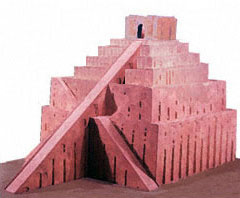
We can piece together quite a bit of information about this tower because of the many imitations built later, after the inhabitants of Babel had been scattered around the world. These are known as stepped pyramids or ziggurats. The shape is that of the pyramids we all know from Egypt, but instead of having smooth sides, they rise in a series of stages or steps.
* Those in Iraq were built exactly as the Bible describes: with baked bricks and tar (Gen. 11:3).**
* The circular Tower of Babel in older illustrations is based on much later Muslim towers found by early European adventurers in Iraq.
** Tar was an obvious choice for mortar in a part of the world where oil and oil products are so plentiful. In ancient times there were many tar pits on the surface of the land which made it easy to find and harvest.
Going up the front of the ziggurat was a huge stairway that ascended to the top, understood to be a stairway to heaven. At the very top was originally a small chapel, sometimes of a different color than the rest. In later times, it was believed that the god would sometimes visit this chapel and spend the night, or descend its stairs to other chapels built at the base to inhabit one of the statues of the gods there. Herodotus, in the 5th century BC, reports the continuation in this upper chapel of one of the same practices that led to the Flood: human women being given as wives to the gods, or as the Bible identifies these sons of God,
fallen angels (1 Cor. 10:19-20, 2 Pet. 2:4, Gen. 6:2, Histories 1.181.2-182.2).
The religious use of these towers was, of course, based on a lie. The real God has no need of a man-made stairway to go up and down between heaven and earth. This was a human invention that flattered man’s pride, not a heavenly necessity. This was also the message of Jacob’s dream at Bethel, when he saw a visionary ladder and the angels of God going up and down to heaven. As he said after the vision had ended: This is the gate of heaven
—right there where he was, alone with God, and not in the step-pyramids of Mesopotamia to which he was travelling (Gen. 28:17).
Jewish and Christian tradition connects the Tower of Babel with a man called Nimrod. He’s mentioned in the Bible as a great hunter
and it’s said that he ruled over several cities in the plain of Shinar (Gen. 10:8-10).* But legend claims to tell us much more: that he is the one that made all the people rebel against God. He was the first to make war on other peoples, and the first man to rule the world. He built the Tower of Babel for the worship of idols; and that he had all the world worship him as a god. They also say that Nimrod started magic, astrology, and even human sacrifice.
* Though this likely refers to the time after the fall of Babel and the division of the nations.
These legends have little historical value. But if we remove Nimrod’s name, they provide a pretty accurate list of the terrible things that did in fact come out of Babylon (or Babel). This is where the worship of idols was first turned into a city-wide and eventually a national cult, with tremendous power for the priests and kings that controlled them. Modern and ancient history also trace astrology and certain kinds of magical divination back to ancient Babylon. It’s also been connected with the origins of human sacrifice and ritual prostitution.
Because of this evil Babylonian religion, God judged the earth again, this time by confusing the languages of the people: a curse that continues right up until today (Gen. 11:7). And because of that curse, wars and conflicts began to grow up between different groups of people. God used these conflicts to separate the nations into their places, all over the world.
This is a very different story about the origin of language than we hear from modern science. But if evolution were really true, we would expect languages to start out very simple, as a series of grunts, and get increasingly more complex over time. But in fact the opposite is true: the oldest known languages are the most complex—even the languages of tribal peoples, while modern languages spoken in so-called advanced
societies—like English or Chinese or Spanish—have been greatly simplified over the years. This is exactly the opposite of what evolution predicts, and strong support for the Bible.
The wars brought about by the confusion of languages led to elaborate fortifications that suddenly appear everywhere, huge walls around cities that had not been there before. This is when ziggurats, like the Tower of Babel, were first built all over Mesopotamia (ancient Iraq). But this didn’t just happen in Iraq: Step pyramids made of stone or dirt can be found all over the world.
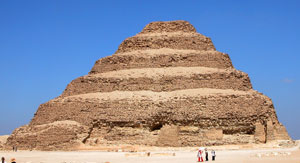
The most famous pyramids are, of course, in Egypt. But did you know that the oldest pyramids in Egypt are also step-pyramids? Other pyramids can be found in Iran, in Sudan (ancient Cush), in Syria, in Turkey, in Greece, in Spain (Tenerife in the Canary Islands), on the islands of Sicily and Sardinia, in France, in England (though conical in shape), in Ireland, in Uzbekistan, on the island of Mauritius, in India, in Sri Lanka, in Cambodia, in Myanmar, and in China, where there are hundreds of large and small earth pyramids near the ancient capital of Xian. These include the pyramid built above the tomb of the first emperor of China, Qin Shi Huang (259–210 BC), with its many terracotta soldiers, one of the most popular tourist spots in China.
Other pyramids have been discovered in Inner Mongolia (from about 3,000 BC), in the Qinghai province in Western China, in Eastern China, in Korea, in Japan, in Indonesia, in the Tonga Islands and New Guinea, in Tahiti, Western Samoa, and Micronesia.
But the prize for the longest continuous use of pyramids goes to North and South America, where they first appear in Peru in 2627 BC—at the same time they first appear in Egypt. Here, in the Americas, pyramid building continued through civilization after civilization until the Spanish conquest in the 16th century: a time span of more than 4,000 years!
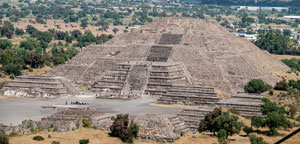
The largest pyramids in the world are not in Egypt, but in Mexico. The third largest pyramid in the world is in Illinois in the United States: a dirt pyramid, which has recently been found to have a stone core.* Hundreds of pyramids can be found all over Mexico, Belize, El Salvador, Bolivia, Guatemala, Honduras, and Peru.
* Monk’s Mound at Cahokia Mounds State Park near St. Louis.
The stepped pyramids of Central and South America are closely related to the ziggurats of Sumer and Babylonia. Like them, they are step pyramids with a central staircase and a temple at the top. Others, made from dirt, can also be found all up and down the Mississippi river in the United States. Here they are known as Indian mounds. The smaller mounds are simple burials, but many of the larger ones are square-based dirt pyramids, which once held a temple on top, just like the pyramids in Mesopotamia. As many as twenty of these dirt pyramids could be found in each of the larger villages. As recently as a hundred and fifty years ago, 20,000 Indian mounds could still be seen in Wisconsin alone. Now, because of land development, only about 2,000 remain.
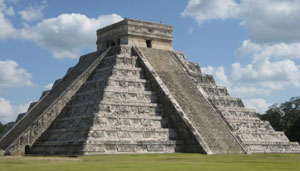
But hundreds more can still be seen in Illinois, Alabama, Louisiana, Minnesota, Arkansas, Mississippi, Missouri, Indiana, North Carolina, South Carolina, Tennessee, Kentucky, West Virginia, Ohio, Georgia, and Florida. There are even a couple in Texas, Arizona, Oregon, Utah, California, North Dakota, South Dakota, New Mexico, Iowa, Michigan, New York, Virgina, and Oklahoma.
One of the remarkable things about these step-pyramids is that the earliest ones (outside of Sumer) all appear at about the same time: 2700 BC, which is the same date given in Genesis for the Tower of Babel (in the Septuagint or Old Greek version). The early step-pyramids of Egypt date to 2600 BC. The earliest pyramids in Greece are dated 2700-2100 BC. The oldest pyramids found in Uzbekistan are dated to 2700 BC. The earliest pyramids in China’s Shensi province are dated to 2500 BC, and in Inner Mongolia to the same general time frame (~3,000 BC). Even the earliest in the New World, in Peru, is dated to 2627 BC. This is an amazing synchronicity! What this means is that in a very short period of time after God struck the Tower of Babel, maybe within one or two hundred years, the Babylonian religious system had already been taken all over the earth.
Why did all these different cultures choose the same basic shape for their temples? Why not a five or six sided mound? Why a hill and not a depression in the ground? It’s hard to explain such great similarity all over the world unless there’s a historical link between them. That link is found in the Bible, in the story of the Tower of Babel.
Something else linking this Babylonian-style world religion is a fascination with the stars and planets, in which the planets are identified as gods. Archeologists have found literally hundreds of examples of pyramids, as well as other ancient buildings, structures, and tombs built in alignment with the movements of the sun, the moon, and the planets. Did you know that the twelve zodiac signs, which divide the night sky into regions of 30° each, were invented by the ancient Sumerians and Babylonians? The 360° circle, the 60 minute hour, the 24 hour day: all these come from ancient Babylon and Sumer.
Their interest in the stars was not a purely scientific interest, but part of the religion of astrology that is remarkably similar wherever it is found around the world.* Did you know that astrology, even today, is not based on how the signs actually appear in the sky, but on how they appeared more than 4,000 years ago: at the time of the Tower of Babel?** Here is another link with ancient Babylonian religion.
* Chinese astrology is an exception. It has it’s own unique system.
** Because of the precession of the equinoxes, the actual constellations are off by one sign today, so what was in Aries, for example, is now in Pisces. But astrology practitioners still use the old, outdated positions.
Another similarity is the practice of human sacrifice around the world: in Europe, the Americas, in Asia, and in Africa. It was particularly bloody in the Americas, where at the top of their pyramids, beating hearts were ripped out of living victims and offered to the sun god. Human sacrifices are often found buried in pyramids and other ancient religious structures.
When a king died, his entire court was often killed and buried with him. This could be hundreds of people. In early Egypt (in Pre-Dynastic & First Dynasty Egypt), servants and administrators were buried with the king or queen by the hundreds. In the ancient African kingdom of Kerma, with its dirt pyramids, as many as five hundred people were buried with a dead king. Then, in Egypt (in the Old Kingdom period) someone introduced the merciful idea of replacing living servants with little model servants, shawabtis, that they believed would come to life and serve the dead. The same thing happened in China. Originally, a dead leader would be buried with his wives, slaves, and soldiers (this was in the Shang dynasty). But Qin Shi Huang, the first Chinese emperor (3rd cent. BC), had a huge terracotta army built instead near his burial pyramid. From that time on the family and servants of an emperor or leader were allowed to live.
In India, human sacrifice continued up until the 19th century in the suttee ritual, in which a wife was thrown on the funeral fire of her husband. Similar rituals were observed by the ancient Thracians, Scythians, the Egyptians, the Scandinavians (in burning ships), the Celts, the Chinese, and the peoples of Oceania and Africa. As the Bible says, the fear of death brought people into slavery to death and to Satan, who had the power of death (Heb. 2:14-15). Mankind lived in a world of fear and uncertainty.
This is just a tiny taste of the horrible impact of Babylonian civilization on the world, with its spiritism and demonism, its idolatry and slavery, its wars and oppression. Fortunately, God wants to restore the Golden Age that existed before Babel, when people lived together in harmony. Jesus called this coming age the regeneration
(which literally means Genesis again,
Matt. 19:28). Even the curse of the division of languages will be reversed. This was hinted prophetically on the Day of Pentecost, when they were each one hearing them speak in his own language
(Acts 2:6). May God bring that day soon!